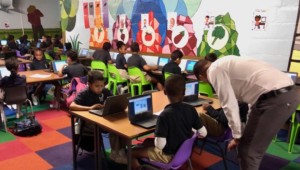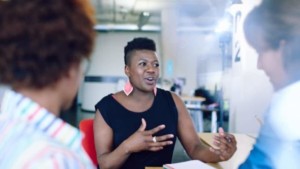Four Key Ingredients For The Teacher PD Revolution

By Jennifer Pieratt
The Teacher PD Revolution is a movement sweeping our country. It’s truly the collective unrest of teachers in the realm of professional learning opportunities. There is a lot of contradiction between what learning should look like for our students and what it currently looks like for us as adults.
We have all sat through countless PD workshops that are top-down, sit-and-get sessions—not reflective of our needs, not clearly aligned to everything that is being asked of us and, to put it bluntly, a waste of our time. Not to mention that as we push further into 21st-century learning, we are living a contradiction by going about our own learning in ways that do not reflect the deeper learning practices we are being asked to facilitate for our students.
I first learned that the teacher PD revolution was “a thing” during a PBL twitter chat co-hosted by New Tech Network and High Tech High. The recipe for a revolution was brewing. Teachers began using the hashtag #pdrevolution and #reimaginepd in tweets to share their frustrations with trainings they had attended.
But more importantly they also coupled them with incredible ideas for revisioning what engaging professional learning should look like for adults. Ideas such as badging, passion-driven professional learning plans, inquiry based learning opportunities provided by their leadership, and MOOCs to support their self-identified Problems of Practice.
The message was clear: Teachers are tired of PD that doesn’t honor or empower them to improve their craft, and that’s what makes this an opportune moment we are in right now.
The following is what I’m calling “The Recipe for a Teacher PD Revolution.” When these four key ingredients are present, you will know your community is ready to take up the cause of a teacher PD revolution:
1. Teacher Leaders are Empowered
Put simply, “when school leaders empower teachers, better ideas emerge.” In my time in schools across the country, I have observed that when teachers do not feel empowered to make decisions about their classrooms, they in turn lose ownership over their own learning and that of their students. With this lack of ownership comes a lack of engagement that is at the cost of the outcome we all seek: deeper learning.
When teachers are honored as professionals, given voice and trusted for their experience and talent, an inspiration is ignited that is passed on to students—this is the ultimate goal of the teacher PD revolution. This synergy moves beyond a basic distributed leadership model and truly allows teachers to share leadership over learning-both students and adults. To see this work in action check out how Bulldog Tech or Denver Public Schools is going about this work.
2. A Learning Organization Foundation Exists
“A learning organization is an organization skilled at creating, acquiring, and transferring knowledge, and at modifying its behavior to reflect new knowledge and insights.”
As we’re in the business of learning, it seems only right that we live the model and go about our own learning in intentional ways. Unfortunately, the work of upholding a learning organization is easier said than done. David Garvin explains that new ideas are essential to becoming a learning organization, and equally as important are the structures which uphold those new ideas.
Jim May of New Tech Network does a great job of transferring this organizational concept to the work of schools in this quick video. May helps us see that a clear focus is also integral to the work of learning together as adults.
This case study shows us May’s ideas in action in a New Tech School, and also highlights what an incredible effort it takes to collectively learn and improve. When ideas and focus meet action and intention, the infrastructure for coming change is established.
3. Adult Agency is Nurtured
With a growing body of research and interest in growth mindsets, the phrase has become mainstream across most schools in our country. As school leaders and teachers begin to ask more from our students in this realm, it is becoming increasingly apparent that we as adults must model what we are asking of our students: agency. The most comprehensive definition I have come across for the term “agency” is actually laid out in the form of a rubric by New Tech Network here.
In the places that are ripe for a revolution, this tool is being used not just for students but teacher behavior as well. District and school leaders are looking to teachers to seek challenges and find personal relevance in their work. In these same places, teachers are supported in their learning and honored for modeling what is being asked of students through any of the following:
- Certification for MOOC participation
- Extension units for self-paced tutorials such as PBL in your PJs
- Release time for Problems of Practice in which colleagues learn and improve alongside one another
- Staff time dedicated to Virtual PLCs
- Micro-Credentialing (ie.,badging) recognitions such as this one
4. Deeper Learning is Modeled for Adults
So often when we discuss deeper learning we tend to only think about K-12 students. However, when we step back and review this definition, it’s easy to see that what we believe about quality learning applies to all ages. So what does this look like when it comes to professional development?
Well it doesn’t look like the typical trainings and conferences where teachers sit in rows and take notes in provided workbooks. Rather, the teacher PD revolution looks like adults engaged as learners through things like project slices that are debriefed to analyze implications for teaching practice. It looks like educators in the community engaging in fieldwork as a learner to better understand the needs for scaffolding deeper learning for their students. It looks like teachers building and making prototypes of projects. And in all of these examples, the adults are collaborating, reflecting and analyzing (amongst many other skills)—in other words, they are embodying the Deeper Learning Competencies we hope to see in our students.
Once the above ingredients are in place, then your community is ready to join the progressive groups in our country that are currently churning the teacher PD revolution. I look forward to marching on with you all as we work toward domination of deeper learning for students and adults! Be sure to follow the movement on Twitter with the hashtag #pdrevolution.
For more, see:
- 3 Learning & Development Tips for Creating Powerful Teacher PD
- Teaching the Teacher: Lesson Planning and Powerful PD in One
- MakerEd Micro-Credentialing: Teachers Want to Play, Too!
Jennifer Pieratt is the Founder and President of CraftED Curriculum and a former teacher. Follow her on Twitter: @JennyPieratt.
Stay in-the-know with all things EdTech and innovations in learning by signing up to receive the weekly Smart Update. This post includes mentions of a Getting Smart partner. For a full list of partners, affiliate organizations and all other disclosures, please see our Partner page.





0 Comments
Leave a Comment
Your email address will not be published. All fields are required.